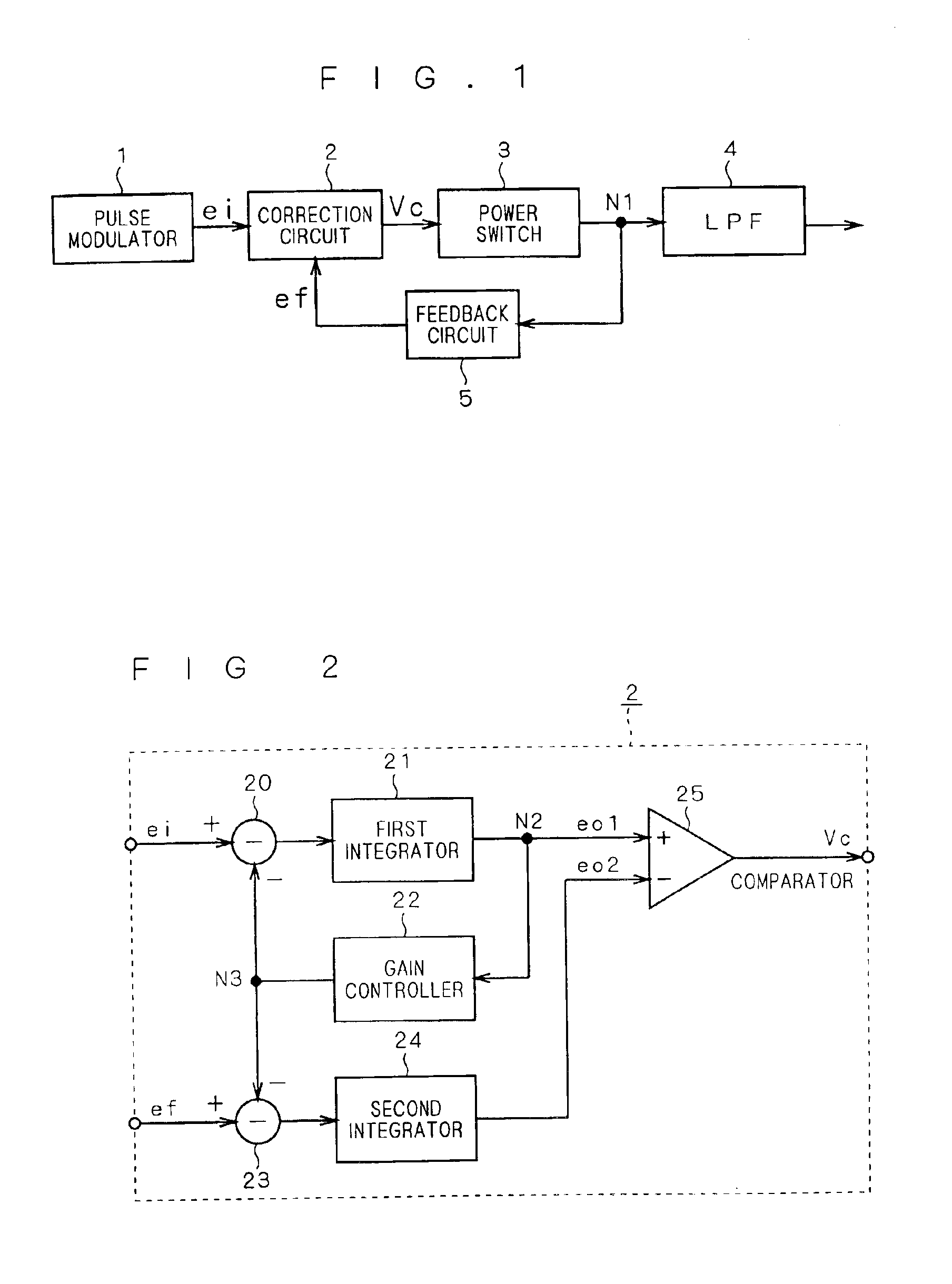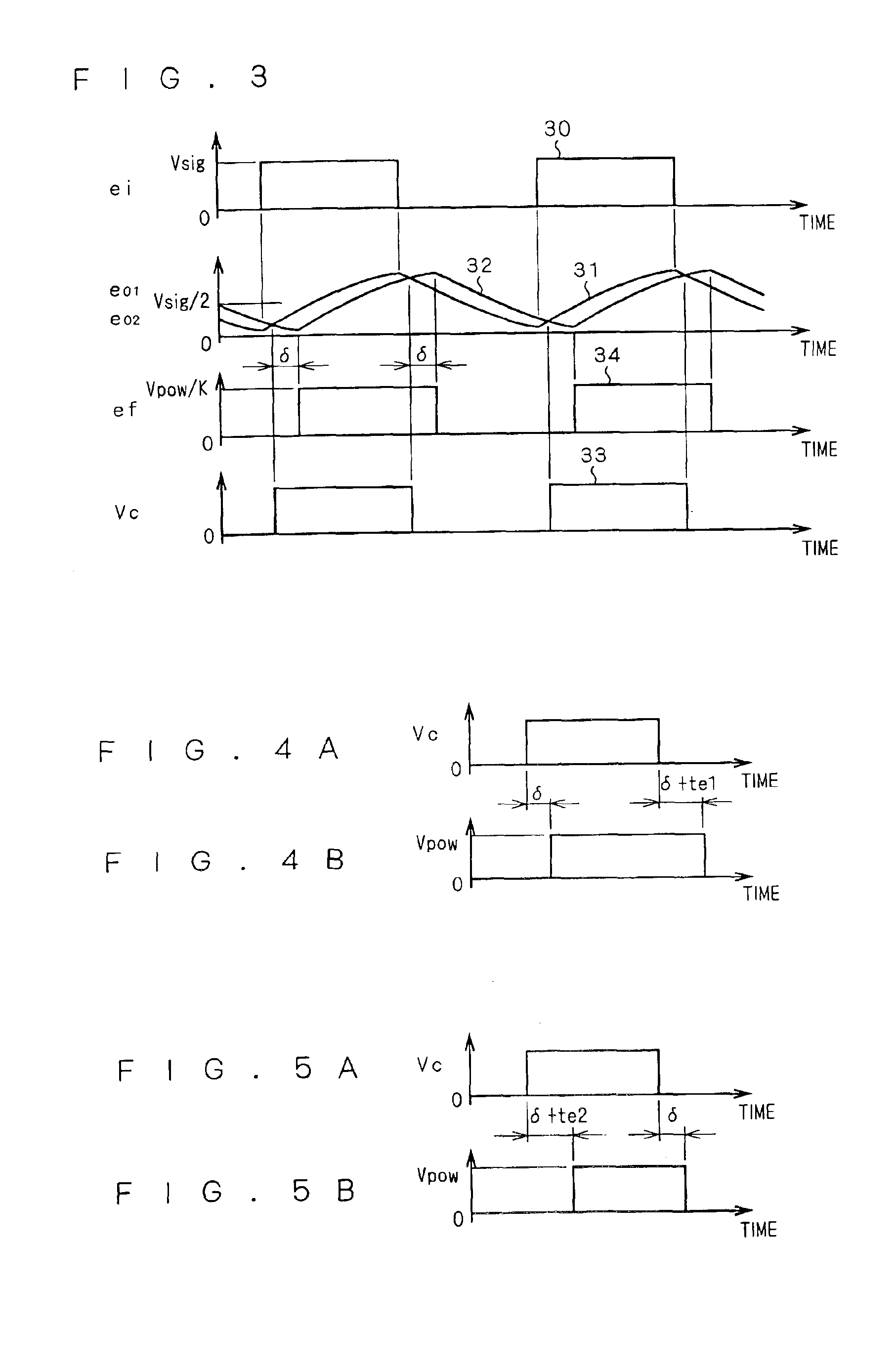Class D amplifier
a class d amplifier and amplifier technology, applied in the direction of amplifiers, dc amplifiers with modulators/demodulators, semiconductor devices/discharge tubes, etc., can solve the problems of loss of inherent advantages of class d amplifiers, difficulty in turning on one of the switching devices connected to the constant voltage power supply, and increase the consumption power of constant voltage power supplies. , to achieve the effect of reducing distortion in audio signals, simple circuit configuration and high accuracy
- Summary
- Abstract
- Description
- Claims
- Application Information
AI Technical Summary
Benefits of technology
Problems solved by technology
Method used
Image
Examples
first preferred embodiment
[0084]A correction circuit included in a class D amplifier according to the present embodiment is capable of integrating a pulse modulated signal output from a pulse modulator and a feedback signal output from a power switch, comparing integrated signals in a comparator using the pulse modulated signal as a reference for outputting an output signal corresponding to the result of comparison to the power switch, and finally correcting signal distortion occurring in the power switch.
[0085]FIG. 1 is a block diagram illustrating the circuit configuration of the class D amplifier according to the present invention including the correction circuit.
[0086]The class D amplifier illustrated in FIG. 1 includes a pulse modulator 1, a correction circuit 2, a power switch 3 and a low-pass filter (LPF) 4 connected in series to each other. A signal is transmitted from the pulse modulator 1 to the LPF 4. A feedback circuit 5 is provided between a node N1 and the correction circuit 2 such that part of...
second preferred embodiment
[0208]The correction circuit according to the present embodiment is to be incorporated in the class D amplifier shown in FIG. 1 described in the first preferred embodiment. The correction circuit is not for directly comparing a signal from the first integrator and that from the second integrator, but for obtaining the difference between the signal from the first integrator and that from the second integrator in a subtracter and then comparing an output signal (differential signal) from the subtracter and a signal obtained by integrating the differential signal in a third integrator and then reversed in a reverser, thereby generating a correction signal.
[0209]A block diagram of the inner configuration of the correction circuit 2 according to the present embodiment is illustrated in FIG. 13. The configuration shown in FIG. 13 will be specifically described hereinbelow. In FIG. 13, the subtracter 20, first integrator 21, gain controller 22, subtracter 23 and second integrator 24 have t...
third preferred embodiment
[0308]FIG. 22 is a block diagram of the configuration of a class D amplifier according to a third preferred embodiment of the present invention. The class D amplifier comprises the pulse modulator 1, correction circuit 2, power switch 3, LPF 4, feedback circuit 5, a speaker 406, a first constant voltage control circuit 407, a second constant voltage control circuit 408, dc output reference signal generator 410 and an arithmetic unit 411. The class D amplifier is supplied with a supply voltage Vcc from an external source through a power terminal 409.
[0309]The pulse modulator 1 generates a pulse modulated signal, and the power switch 3 performs switching between the power supply and ground in accordance with a correction signal corrected in the correction circuit 2, enabling power supply to a load (speaker 406) connected to the output of the class D amplifier. The switching operation is carried out by switching devices configured as described in the first preferred embodiment.
[0310]Th...
PUM
 Login to View More
Login to View More Abstract
Description
Claims
Application Information
 Login to View More
Login to View More - R&D
- Intellectual Property
- Life Sciences
- Materials
- Tech Scout
- Unparalleled Data Quality
- Higher Quality Content
- 60% Fewer Hallucinations
Browse by: Latest US Patents, China's latest patents, Technical Efficacy Thesaurus, Application Domain, Technology Topic, Popular Technical Reports.
© 2025 PatSnap. All rights reserved.Legal|Privacy policy|Modern Slavery Act Transparency Statement|Sitemap|About US| Contact US: help@patsnap.com



